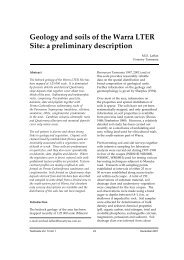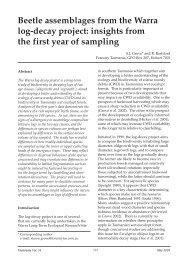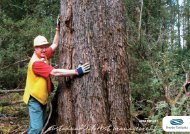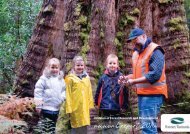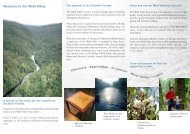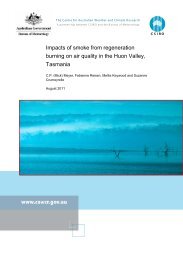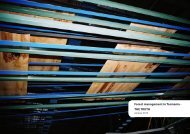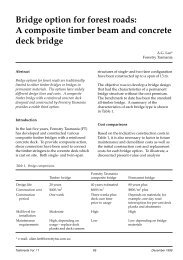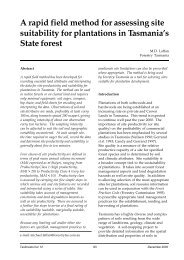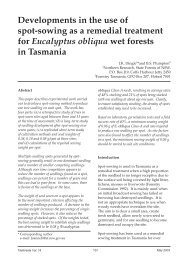The natural distribution of Eucalyptus species in Tasmania - Forestry ...
The natural distribution of Eucalyptus species in Tasmania - Forestry ...
The natural distribution of Eucalyptus species in Tasmania - Forestry ...
Create successful ePaper yourself
Turn your PDF publications into a flip-book with our unique Google optimized e-Paper software.
to north-east trend <strong>in</strong> the upper and lower<br />
altitude limits <strong>of</strong> E. delegatensis parallels<br />
the observations for the alp<strong>in</strong>e tree-l<strong>in</strong>e <strong>in</strong><br />
<strong>Tasmania</strong> (see Kirkpatrick 1982). However,<br />
E. delegatensis is also recorded at relatively<br />
low altitudes (150–400 m) along the northern<br />
marg<strong>in</strong>s <strong>of</strong> its range, consistent with similar<br />
low altitude occurrences <strong>of</strong> E. dalrympleana.<br />
<strong>The</strong> ma<strong>in</strong> flower<strong>in</strong>g period is from January<br />
to March, peak<strong>in</strong>g <strong>in</strong> January and February<br />
(Figure 26).<br />
<strong>Eucalyptus</strong> delegatensis (Figure 27) dom<strong>in</strong>ates<br />
a range <strong>of</strong> community types and is strongly<br />
associated with substrates derived from<br />
Jurassic dolerite, which are typically freedra<strong>in</strong><strong>in</strong>g<br />
and have a high surface-rock cover.<br />
In upland tall, wet forest, such as <strong>in</strong> the northeastern<br />
highlands and Western Tiers, under-<br />
Figure 25. Altitude <strong>distribution</strong> <strong>of</strong> E. delegatensis.<br />
n = 65<br />
Figure 26. Flower<strong>in</strong>g times for E. delegatensis.<br />
n = 2744<br />
storeys vary from ra<strong>in</strong>forest to mesophytic<br />
shrubs. On the moist ridges, plateaux and<br />
slopes <strong>of</strong> the Eastern Tiers and south-eastern<br />
Central Plateau, a shrubby or grassy dry<br />
sclerophyll understorey develops <strong>in</strong> open<br />
forest. Open forest gives way to woodland <strong>in</strong><br />
subalp<strong>in</strong>e climates and <strong>in</strong> the drier regions <strong>of</strong><br />
undulat<strong>in</strong>g country on the upland marg<strong>in</strong>s <strong>of</strong><br />
the Midlands and Derwent Valley. <strong>Eucalyptus</strong><br />
delegatensis frequently forms pure stands <strong>in</strong><br />
wet forests but may co-exist ecotonally with<br />
E. obliqua at lower altitudes, with E. regnans<br />
on the more fertile sites, or with E. amygdal<strong>in</strong>a<br />
as moisture availability decreases. In subalp<strong>in</strong>e<br />
situations closer to the tree-l<strong>in</strong>e, it may coexist<br />
with E. coccifera, or with E. pauciflora <strong>in</strong><br />
the <strong>in</strong>verted tree-l<strong>in</strong>e near the marg<strong>in</strong> <strong>of</strong> frost<br />
hollows (Jackson 1973). Typical m<strong>in</strong>or or<br />
subdom<strong>in</strong>ant <strong>species</strong> which co-occur with<br />
E. delegatensis <strong>in</strong>clude E. dalrympleana at higher<br />
altitudes or E. vim<strong>in</strong>alis at lower altitudes.<br />
COMMENTS: In the far north-west, scattered<br />
records <strong>of</strong> E. delegatensis (i.e. cells 3143, 3341,<br />
3344, 3442) may be <strong>in</strong>dicative <strong>of</strong> other western<br />
locations that are currently considered<br />
unverified outliers (i.e. cells 3548, 3631, 3633,<br />
3724). Western, low-altitude occurrences are<br />
recorded from the Heemskirk River region<br />
(cells 3536, 3537) and Cumberland Hill (cell<br />
3435), and eastern, low-altitude occurrences<br />
are known from Mount Pearson near<br />
St Helens (373 m, cell 6043), which is exposed<br />
to the prevail<strong>in</strong>g weather <strong>of</strong> the north-east.<br />
Many <strong>of</strong> the southern coastal forms <strong>of</strong> E. obliqua<br />
(e.g. see cells 4517, 4717 <strong>in</strong> Figure 43) appear<br />
similar to E. delegatensis, with rough stem<br />
bark and smooth branches but are otherwise<br />
morphologically true to E. obliqua (F. Duncan,<br />
pers. comm. 1994). Occasional hybrids<br />
between E. obliqua and E. regnans <strong>in</strong> the<br />
Southern Forests (e.g. Lune River to Cockle<br />
Creek, cells 4818, 4819) and Tasman Pen<strong>in</strong>sula<br />
(e.g. cell 5722) are sometimes <strong>in</strong>correctly<br />
ascribed to E. delegatensis (M.J. Brown, pers.<br />
comm. 1994). Such hybrids may also account<br />
for some <strong>of</strong> the low-altitude, unverified<br />
outliers <strong>in</strong> the north (e.g. cell 3945, 5145) and<br />
other low-altitude occurrences recorded here<br />
for E. delegatensis (Figure 25).<br />
Tasforests Vol. 8 67<br />
December 1996




